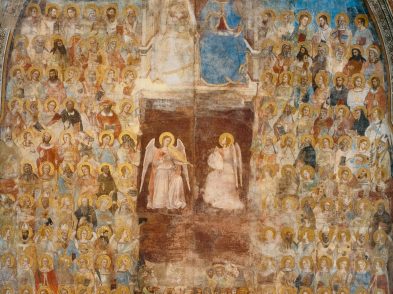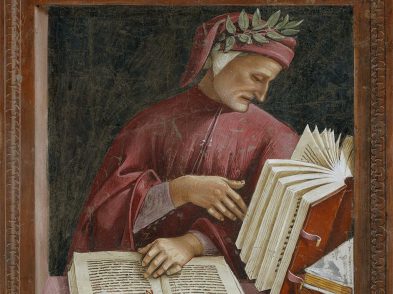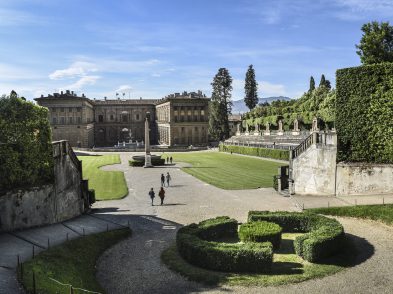After having worked in Paris, Frankfurt, Amsterdam and other cities in North America, what is your take on Florence? Is it a cosmopolitan city?
Florence is the most extraordinary city I have ever lived in. I say this for two main reasons. First, for its size: it is so compact; everything is close to the center. The city is truly on a human scale. Second, Florence has the highest concentration of intellectual, creative and business firepower that I have ever seen. It punches way above its weight. You can compare it to Cambridge, England for the quantity and quality of stimulating conversation. It’s extraordinary! Here everyone from art historians to plumbers is able to carry on extraordinary conversations about art, literature-you name it. The question is why doesn’t Florence do more with this firepower?
Palazzo Strozzi offers a rich and varied range of cultural activities beside exhibits. Tell us about the idea of the Palazzo as a ‘cultural piazza.’
Our goal is to be a catalyst for culture-a place where people can meet, talk and make the city better. We are not out to create a niche for ourselves as an exhibit space; we’re here to provide a platform and laboratory for Florence to experiment with how to use its cultural resources to maximum effect. This is what sets us apart from the traditional cultural institutions, which are slow, careful and prudent-as they should be. Their function is to conserve. But we need laboratories like Palazzo Strozzi to take risks, find ways of creating, find synergies and act as catalysts. Institutions can then decide to implement changes as they see fit. We are not a recipe for others; we are a laboratory where all can learn.
I don’t think of targets in terms of ticket sales or number of single visits, but in terms of users. We want people dropping in to have a coffee and use the wireless Internet in the courtyard (which, by the way, we think of as our third programmable space, thanks to the various installations). In some aspects, we see the number of users as the fulfillment of Palazzo Strozzi’s role as a place where people who love Florence come to get connected and feel at home in the juxtaposition of different themes and historical periods. In fact, we have seen over the last two years that Palazzo Strozzi has become more dynamic, more loved and more used.
What is the Strozzi Foundation doing to attract people to Florence?
Palazzo Strozzi is not really a place for the first-time tourist: it is a place for the second- and third- time tourist. In creating synergies with other cultural and creative forces, we are offering a quality service. Our programs are getting noticed all over the world. This is not a case of Italy or Florence ‘catching up’ to the rest of the world: we are bringing international quality to Florence and showing that this city can lead and has new knowledge to be shared.
What about locals? Does the Foundation offer any cost-saving initiatives to get them coming back to Palazzo Strozzi?
Locals are coming to the shows, in fact, over 40 percent of our visits are repeat visits. This includes students, professors, families, teenagers. For €20 we offer season tickets and family tickets (two adults and two children), which are both great values. Every ticket to the Strozzina is good for a month. Another great benefit is the ‘passport’ we produce for each show-it promotes other businesses, places, cultural entities in town and offers reduced or free entrance to the Palazzo Strozzi’s exhibition to those who get five or more stamps in their passport.
Families and children are obviously very important to the Foundation as evidenced by the various activities offered during the shows. What is the idea behind the activities, workshops, books and so on?
We have a fundamental respect for the intelligence of children. They are incredibly smart but lacking in background, so we seek to provide that background. We maintain respect for the content; we don’t dumb things down. Take the Impressionists exhibit, where we had kids looking at the paintings through magnifying glasses-that’s what curators do!
Jonathan Miller once said ‘the life of the mind is a pleasure.’ This starts with kids. It is about teaching children to become curious, interested citizens of the world. Louis Kahn said that people remember visits to museums not for the content, but for the experience, which could end up even changing the direction of their lives. People don’t usually go museums to look at paintings but to talk about looking at paintings. We want to create the same experience for children so that they remember the visit or the thing that first sparked their interest during a visit to one of our exhibitions.
Last August, the Palazzo and its exhibits stayed open. Do you plan on doing this again in 2009?
Absolutely! Staying open in August promotes a double mission of international quality that is deeply rooted in Florence. By being open in August we are saying, ‘We’re here for you; we’re not going to the beach!’ In the world of globalized tourism, if you believe your job is serving people, then staying open when others go on holiday is your cross to bear.
Tell us more about the Strozzina; it houses a contemporary art space in one of Florence’s most important Renaissance palazzos.
Florence has a deep connection to its Renaissance past, but citizens have a right to feel part of 2009, to have a place that feels like a city of today. I was trained as an architect and am in awe of some of the modern structures in the area, like the Santa Maria Novella train station and the Chiesa dell’Autostrada. We are living and working with the active trace of greatness all around us, from every century, which should be an impulse to participate and fully recognize that we live in this amazing city.
What are the advantages and disadvantages of being a foreigner in your position at the Foundation?
Not being from Florence has its pluses and minuses. The minuses are that my Italian is rough and as a foreigner I am obviously not included in certain specifically Florentine discussions. On the plus side, I have a great deal of independence as a director. One main advantage is that I see the city the way most visitors see it, as a foreigner, which means I can be a real ambassador for Florence in the world. I have a great love for this city and it is decidedly of a different quality than that of a native for his home.
We are undeniably in the midst of a tough moment with regard to the economy. What impact do you expect it to have on culture?
Economically we are facing a grim situation, and it is going to take all of the resolve of the city and all its partners to get through a couple of very rough years. What is key to remember is that cultural education is not a luxury-it is a necessity. You cannot limit the learning opportunities necessary for the younger generations-who are facing a future social, cultural and economic black hole-and expect to have citizens with the full set of intellectual and creative skills they will need to meet the challenges of the future. We cannot take these opportunities away from them. Further, the laboratory function is the last thing you want to cut, because it helps us prerpare for the difficult challenges we will face in the future. Culture is indispensable; society will collapse without it. This is the time for institutions to put all their resources into play. Florence has so much coal in the basement; we just need to find out how to make heat.
The Foundation has been criticized for the lack of ‘heavy hitters’ in terms of exhibits. How do you respond to that?
If Italy has one vice, it’s doing everything at the last minute. When I first arrived at the Foundation, there was no long-term plan in place. We had a very short time to come up with a three year plan, which I insisted on, but for which we paid a certain price in terms of the choices we could make in terms of possible exhibitions. But even with the constraints of quick long-term planning, we came up with a strong set of exhibitions that range from the fine arts to applied arts, sciences, and more.
Our exhibits are not blockbusters, they are not ‘edu-tainment’. The book cannot be judged from the cover, nor the quality of an exhibition from its nominal content. The point is how we do things, the quality behind the experience. The last four exhibitions all show how exciting different kinds of content can be: fashion, Chinese art, Impressionism and Medici tapestries. Our exhibits are for everyone, not just those who define themselves as art lovers or intellectuals. To detractors, I would say: Have patience, we are redefining the logic of culture, moving it beyond culture as consumption towards culture as a sustainable resource.
What is in store for the next few years?
During 2010 and 2011 we have several fabulous ‘big name’ shows lined up: De Chirico, Magritte, Balthus, Bronzino, Picasso, Dali, Mirò and Ingres, as well as thematic summer shows: art, money and power in 2010 and the role of women in Renaissance Florence in 2011. We have two internationally known writers, Tim Parks and Sarah Dunant co-curating these particular shows. These are real writers writing the labels in their voices. Again, this is not Italy catching up-nobody else is doing this-Florence is leading the way.
You are one of the few museums in town to incorporate English in all aspects of your activities, from books to didactic materials to workshops. What is the importance of that?
We believe in language, and we JB: We believe in language, and we believe the first courtesy we can show to our guests is to communicate in their language. English is the most common second language of our visitors; therefore everything we produce is also available in English. We host lectures and children’s workshops in English. We often provide a third language as well, depending on the show’s content, for instance Chinese for the Court of the Emperors, and French for the Medici tapestries.
A foundation needs to be like a person, to exhibit the same values a person might: generosity, courtesy, humility and kindness. We go out of our way to make our space as user-friendly as possible. Again, the goal is to make the experience worthwhile, so that the visitor leaves with an emotional feeling.
What is special about the upcoming Galileo show?
The show is the centerpiece, along with important shows in Pisa and Padova, of Italy’s celebration of the 400th anniversary of Galileo’s invention of the telescope. We look at astronomy before the advent of the telescope, when astronomy was part of the odyssey of the human imagination, astrology, of religion. The show is full of objects. It’s very dense and intense. There is multimedia throughout. And of course, you can’t look at the stars without a black box, so the whole exhibition space is darkened. In addition to the usual family and children’s labeling, families can get a ‘saddlebag’ filled with a wide variety of activities and instruments to help guide them through the exhibit. The children’s book includes illustrations by Caldecott Award-winning illustrator, Peter Sis. The passport includes exhibits all over Tuscany, from Lucca to Pisa, Pistoia and Siena. I hope people come away with a sense of the psychological drama in finding the significance of our place in the universe.








